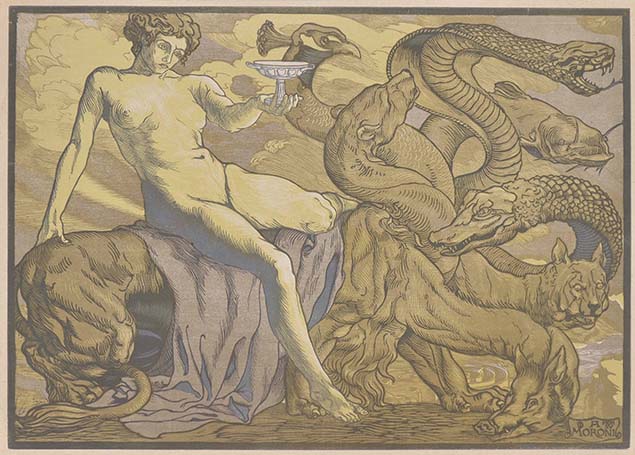(Savignano di Romagna, 1889 – Gatteo, 1929)
LA COPPA D’ORO (I Sette Vizi Capitali, The Seven Deadly Sins), 1915
Chiaroscuro woodcut printed from four blocks. Signed A MORONI and dated MCMXV bottom right in the block. Fine impression, in very good condition. To the borderline 305 x 430 mm, the full sheet 315 x 445 mm.
This woodcut is most likely to be identified with the one entitled I Sette Vizi, exhibited at the Esposizione d'incisione italiana, in London in 1916. An example of the work, among the most significant by Moroni, was purchased in 1917 by the Regia Accademia Nazionale d’Arte Moderna, today the Galleria d’Arte Moderna in Rome. The woodcut subsequently participated in numerous exhibitions. The work is centered, as Emanuele Bardazzi was the first to point out, on the iconographic theme of the depiction of the Whore of Babylon riding the Beast of the Apocalypse, as described in the Apocalypse of St. John. The theme, already codified in the Middle Ages, runs through the entire history of Western art, from Dürer to William Blake.
See Marica Guccini, Il solco sottile, Antonello Moroni artista, xilografo, illustratore del libro, 2016; no 6 p. 118.
After his academic studies in Florence and a long period of inactivity due to illness, Moroni collaborated with Adolfo De Carolis, his teacher, on the frescoes of the great hall of the University of Pisa and those for the Palazzo del Podestà in Bologna. From De Carolis he derived both the Art Nouveau inspiration and the choice of xylography as the main means of expression. As an engraver, he soon began to collaborate with the Zanichelli publishing house in Bologna, for which he produced - in addition to book covers and friezes - illustrations of classics such as the Iliad, the Odyssey and the Aeneid. Moroni was particularly appreciated as an author of woodcut ex libris, works of small and sometimes tiny format in which he demonstrated an extraordinary mastery of technique, a great capacity for synthesis and notable inventiveness. His works are preserved in museums and art galleries, libraries and private collections, starting with the Civic Museum of Forlì. In fact, his widow donated all the artistic material from Moroni's studio to the Artistic and Cultural Institutes of Forlì.
